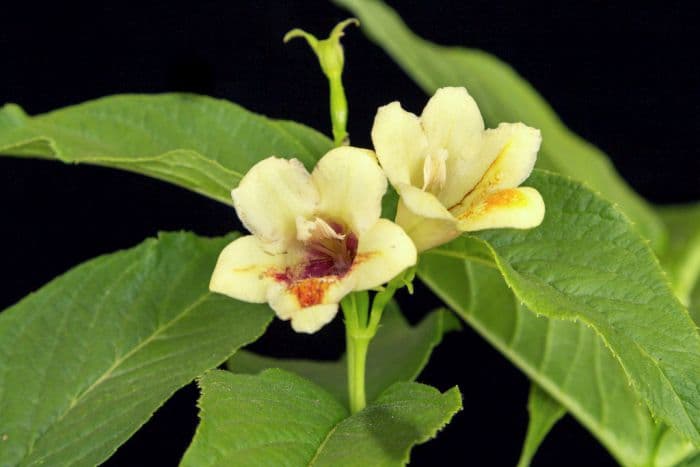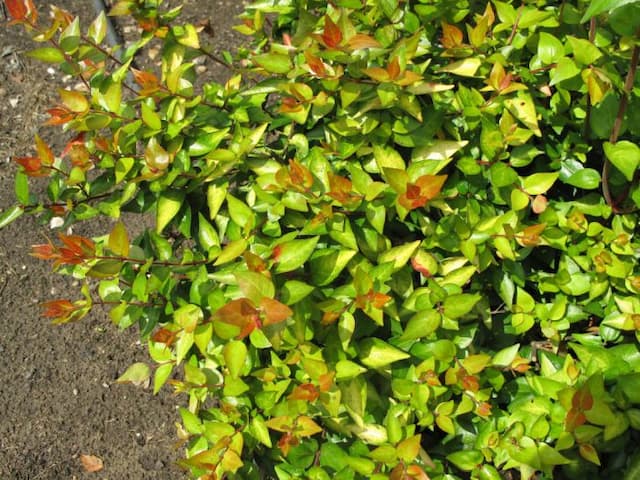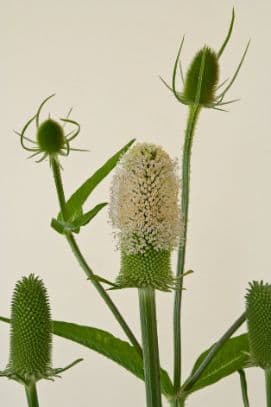Mango Weigela Weigela middendorffiana 'Mango'

ABOUT
Weigela 'Mango' is a decorative shrub that is readily identified by its attractive foliage and blooms. This plant features leaves that have a classic oblong shape with a soft, green hue that provides a luscious backdrop throughout the growing season. The foliage often carries a slight point at the tip and has a clean, smooth edge that outlines each leaf. The true draw of the Weigela 'Mango' is its enchanting flowers. The blooms are trumpet-shaped, a design that tends to attract pollinators such as hummingbirds. These flowers boast a warm, mango-orange color, sometimes suffused with a yellowish glow that seems to capture the essence of tropical hues. The blossoms typically adorn the plant in clusters, creating a generous show of color and interest that can stand out brilliantly against the foliage. The overall form of Weigela 'Mango' can be described as having a rounded and bushy habit, lending itself well to being a focal point in any garden setting. The branches tend to arch gracefully, which can give the plant a somewhat cascading appearance, especially when laden with the weight of its beautiful flowers. Each branch will come to life with new growth every spring, ensuring an annual display that can be quite spectacular. Year-round, this Weigela cultivar provides a robust presence in the landscape. After flowering, the plant continues to maintain its lush foliage, which may take on subtle changes in hue as the seasons progress, before the leaves drop in preparation for winter dormancy. These characteristics make the Weigela 'Mango' a popular choice for gardeners seeking to add long-lasting visual interest and a touch of tropical flair to their plantings.
About this plant
 Names
NamesFamily
Caprifoliaceae
Synonyms
Middendorff Weigela, Mango Weigela
Common names
Weigela middendorffiana 'Mango'.
 Toxicity
ToxicityTo humans
Weigela is generally considered non-toxic to humans. There is no well-documented evidence that ingesting Weigela causes poisoning symptoms in humans. However, it's always advisable to avoid eating ornamental plants as a precaution, and to seek medical consultation if ingestion occurs and any adverse symptoms develop.
To pets
Weigela is not known to be toxic to pets. There are no significant symptoms of poisoning associated with the ingestion of this plant in animals like cats and dogs. However, gastrointestinal upset could occur if a pet eats a large amount of plant material of any kind, so it is always best to keep an eye on your pets and prevent them from eating plants not intended for consumption.
 Characteristics
CharacteristicsLife cycle
Perennials
Foliage type
Deciduous
Color of leaves
Green
Flower color
Yellow
Height
4-6 feet (1.2-1.8 meters)
Spread
4-6 feet (1.2-1.8 meters)
Plant type
Shrub
Hardiness zones
5
Native area
Asia
Benefits
 General Benefits
General Benefits- Attracts Pollinators: Weigela 'Mango' is known for attracting bees, butterflies, and other beneficial insects that promote pollination.
- Decorative Flowers: This plant produces vibrant, mango-colored blooms that can add a splash of color to gardens and landscapes.
- Low Maintenance: Requires minimal care once established, making it suitable for gardeners of all skill levels.
- Drought Tolerance: Once established, it can withstand periods of limited water supply, reducing the need for frequent watering.
- Wildlife Habitat: Provides shelter and nesting sites for birds, adding to the biodiversity of the garden space.
- Seasonal Interest: Has a long blooming season, typically from late spring to early summer, which adds visual interest to the garden for an extended period.
- Hardy: It's able to survive in a range of soil types and various climates, making it adaptable to many environments.
- Compact Growth: With its moderate size, Weigela 'Mango' is suitable for smaller gardens or as part of mixed borders without overwhelming the space.
 Medical Properties
Medical PropertiesThis plant is not used for medical purposes.
 Air-purifying Qualities
Air-purifying QualitiesThis plant is not specifically known for air purifying qualities.
 Other Uses
Other Uses- Artistic Inspiration: Weigela can serve as a muse for artists and photographers due to its striking blooms and structure, providing a natural subject for artworks and photographs.
- Educational Tool: Botany educators may use Weigela to demonstrate plant growth, reproductive biology (flowering), and plant taxonomy in a classroom or garden setting.
- Theme Gardens: Weigela can be incorporated into themed gardens, such as a pastel garden or a hummingbird garden, due to its bright flowers and attractiveness to wildlife.
- Natural Dye: The flowers and leaves of Weigela may be used to create natural dyes for fabric or craft projects, offering subtle color variations.
- Privacy Screens: When planted in a row, Weigela can form a living privacy screen, providing a natural barrier that blooms beautifully during the growing season.
- Hobby Gardening: Cultivating Weigela can be a rewarding hobby for those interested in plant propagation, as it can be easily propagated by cuttings.
- Floral Arrangements: The flowers of Weigela can be used in fresh floral arrangements to add volume and a touch of the outdoors to interior décor.
- Garden Sculpture: Pruning Weigela into certain shapes can provide a form of living sculpture, contributing to the aesthetic of landscaped spaces.
- Bonsai Creation: With the right techniques, Weigela can be trained into a bonsai form, offering an intriguing and beautiful miniature landscape.
- Festive Decor: Around the holidays or for special occasions, Weigela branches with their leaves and flowers can be incorporated into wreaths and other festive decorations.
Interesting Facts
 Feng Shui
Feng ShuiWeigela is not used in Feng Shui practice.
 Zodiac Sign Compitability
Zodiac Sign CompitabilityWeigela is not used in astrology practice.
 Plant Symbolism
Plant Symbolism- Overflowing Abundance: Weigela is known for its profuse and showy blooms, often symbolizing generosity and the bounty of nature.
- Adorned Beauty: The striking flowers of Weigela 'Mango' are a testament to beauty and aesthetics, making it a symbol for outer and inner beauty.
- Endurance: This hardy shrub is able to withstand less-than-ideal conditions, representing resilience and the ability to endure hardships.
- Spring Awakening: Since Weigela flowers in spring, it symbolizes new beginnings and the awakening of life after winter.
 Water
WaterThe Weigela 'Mango' should be watered deeply once a week, ensuring that the soil is moist but not waterlogged. During the growing season, it may need more frequent watering, especially in hot, dry conditions, possibly increasing to twice a week. Use approximately 1-2 gallons of water per plant for each watering session, depending on the size of the plant and the weather conditions. In the winter, water less frequently, allowing the soil to dry out slightly between waterings. Always check the soil moisture at a depth of a few inches to determine if additional water is needed.
 Light
LightWeigela 'Mango' flourishes best in full sun to partial shade conditions. The ideal spot for the plant is in an area that receives at least 6 hours of direct sunlight daily, but it can also tolerate some shade, especially in the afternoon. Avoid deep shade locations, as this can result in fewer flowers and a less robust plant.
 Temperature
TemperatureWeigela 'Mango' is hardy and can survive in a range of temperatures but thrives best when the temperature is between 50°F and 75°F. It can withstand minimum winter temperatures down to about -10°F. Always ensure that the plant is protected from extreme cold by providing mulch or shelter if temperatures are expected to fall below this range.
 Pruning
PruningPrune Weigela 'Mango' immediately after blooming to shape the plant and encourage the growth of more flowers the following season. Typically, this means pruning in late spring or early summer. Remove any dead or crossed branches to maintain good air circulation. Thinning out older stems every few years will help rejuvenate the plant.
 Cleaning
CleaningAs needed
 Soil
SoilThe Weigela middendorffiana 'Mango', commonly known as Mango Weigela, thrives in well-draining soil mixed with organic matter like compost or peat moss to encourage fertility. A soil pH between 5.5 and 7.5 is ideal for this plant. A balanced mix of loam, sand, and some clay can work well. Ensure regular mulching to retain soil moisture and structure.
 Repotting
RepottingMango Weigela, typically grown as a garden shrub rather than a potted plant, does not require frequent repotting. If it is grown in a container, repotting should occur every 2-3 years or when the root system outgrows the pot, usually in the springtime.
 Humidity & Misting
Humidity & MistingMango Weigela prefers moderate humidity levels but is quite adaptable and can tolerate the range of humidity levels commonly found outdoors in its growing zones. It does not have specific humidity requirements and is relatively tolerant of different conditions.
 Suitable locations
Suitable locationsIndoor
Provide bright light, moderate water, and ensure good air circulation.
Outdoor
Plant in sun to part-shade and mulch soil to retain moisture.
Hardiness zone
5-8 USDA
 Life cycle
Life cycleWeigela middendorffiana 'Mango', commonly known as Mango Weigela, begins its life cycle when seeds germinate in the spring, requiring well-draining soil and sufficient warmth and moisture. The seedlings emerge and grow into young plants, developing a fibrous root system and initial foliage. As the plants mature, they enter a vegetative state characterized by the growth of leaves, stems, and branches, preparing the plant for the flowering stage. Flowering occurs in late spring to early summer, with the Mango Weigela producing distinctive trumpet-shaped, yellow-orange flowers that attract pollinators such as bees and hummingbirds. After pollination, the plant forms fruit capsules containing seeds, which, when mature, release the seeds to start a new generation. Finally, the plant enters a period of dormancy in the winter, reducing metabolic activities and growth until the next growing season.
 Propogation
PropogationPropogation time
Spring-Early Summer
Propogation: Weigela middendorffiana 'Mango', commonly referred to as simply Weigela, can be effectively propagated through softwood cuttings, which is the most popular method due to its simplicity and high success rate. The best time to take softwood cuttings is in late spring or early summer, when the new growth is mature enough to handle but has not yet turned woody. To propagate, one would cut a 4 to 6-inch length of stem that includes at least two or three sets of leaves. The lower leaves are removed, and the cut end is often dipped in rooting hormone powder to encourage root growth. The cutting is then inserted into a pot filled with moist, well-draining potting mix, ensuring at least one set of leaf nodes is below the soil surface. The pot is generally covered with plastic to maintain humidity and is placed in a well-lit area without direct sunlight until roots have developed, which usually takes a few weeks. After rooting, the young Weigela can be transferred to a larger pot or planted directly in the garden.








